Laser-Induced Periodic Surface Structures and Their Application for Gas Sensing
Abstract
:1. Introduction
2. Experimental Section
2.1. LIPSS Fabrication on Thermal Oxidized Si Wafer
2.2. LIPSS Fabrication on Plane Si Wafer and Thermal Oxidation Experiment
2.3. LIPSS Generation on Glass by Metal-Supported Backside Ablation
2.4. Metal Oxide Nanoparticle Films on Glass Produced by Confined Laser Plasma Ablation
3. Results and Discussions
3.1. Laser Conditions and Corresponding Surface Structures on Different Materials
3.2. Metal Oxide Nanoparticles on Glass and Their Optical Gas Responses
4. Conclusions
Author Contributions
Funding
Data Availability Statement
Conflicts of Interest
References
- Zehetner, J.; Langer, G.; Riester, M.; Mündlein, M.; Nicolics, J.; Houbertz, R. Thermal analyses of a multilayer with embedded vertical-cavity surface emitting lasers. In Proceedings of the Polytronic 2007—6th International Conference on Polymers and Adhesives in Microelectronics and Photonics, Tokyo, Japan, 15–18 January 2007; pp. 245–250. [Google Scholar]
- Rank, E.A.; Sentosa, R.; Harper, D.J.; Salas, M.; Gaugutz, A.; Seyringer, D.; Nevlacsil, S.; Maese-Novo, A.; Eggeling, M.; Muellner, P.; et al. Toward optical coherence tomography on a chip: In vivo three-dimensional human retinal imaging using photonic integrated circuit-based arrayed waveguide gratings. Light Sci. Appl. 2021, 10, 6. [Google Scholar] [CrossRef] [PubMed]
- Shin, J.; Lee, G.; Choi, M.; Jang, H.; Lim, Y.; Kim, G.-S.; Nam, S.-H.; Baek, S.-H.; Song, H.-C.; Kim, J.; et al. Atomically mixed catalysrs on a 3D thin-shell TiO2 for dual-modal chemical detection and neutralization. J. Mater. Chem. A 2023, 11, 18195–18206. [Google Scholar] [CrossRef]
- Keshavarz, M.; Tan, B.; Venkatakrishnan, K. Functionalized Stress Component onto Bio-template as a Pathway of Cytocompatibility. Sci. Rep. 2016, 6, 35425. [Google Scholar] [CrossRef]
- Bae, G.; Kim, M.; Jang, M.; Kwon, Y.M.; Yim, S.; Song, W.; Myung, S.; Lee, S.S.; Hasan, T.; An, K.-S. Photon-Pen Writing for Metal Oxide-Based Versatile Nanosensors. Adv. Funct. Mater. 2022, 32, 2204821. [Google Scholar] [CrossRef]
- Zehetner, J.; Kasemann, S.; Vanko, G.; Babchenko, O. Black Titanium Dioxide in situ generated on Femtosecond Laser Induced Periodic Surface Structures: Conference Proceedings. In Proceedings of the Twelfth International Conference on Advanced Semiconductor Devices and Microsystems, Smolenice Castle, Slovakia, 21–24 October 2018. [Google Scholar] [CrossRef]
- Bonse, J.; Gräf, S. Maxwell Meets Marangoni—A review of Theories on laser-Induced Periodic Surface Structures. Laser Photonics Rev. 2020, 14, 2000215. [Google Scholar] [CrossRef]
- Bonse, J. Quo vadis LIPSS?—Recent and Future Trends on Laser-Induced Periodic Surface Structures. Nanomaterials 2020, 10, 1950. [Google Scholar] [CrossRef] [PubMed]
- Gnilitskyi, I.; Derrien, T.J.-Y.; Levy, Y.; Bulgakova, N.M.; Mocek, T.; Orazi, L. High-speed manufacturing of highly regular femtosecond laser induced periodic surface structures: Physical origin of regularity. Sci. Rep. 2017, 7, 8485. [Google Scholar] [CrossRef]
- Florian, C.; Déziel, J.-L.; Kirner, S.V.; Siegel, J.; Bonse, J. The Role of the Laser-Induced Oxide Layer in the Formation of Laser-Induced Periodic Surface Structures. Nanomaterials 2020, 10, 147. [Google Scholar] [CrossRef] [PubMed]
- Florian, C.; Wonneberger, R.; Undisz, A.; Kirner, S.V.; Wasmuth, K.; Spaltmann, D.; Krüger, J.; Bonse, J. Chemical effects during the formation of various types of femtosecond laser-generated surface structures on titanium alloy. Appl. Phys. A 2020, 126, 266. [Google Scholar] [CrossRef]
- Lu, X.; Jiang, F.; Lei, T.; Zhou, R.; Zhang, C.; Zheng, G.; Wen, Q.; Chen, Z. Laser-Induced-Plasma-Assisted Ablation and Metallization on C-Plane Single Crystal Sapphire (c-Al2O3). Micromachines 2017, 8, 300. [Google Scholar] [CrossRef] [PubMed]
- Cole, D.F.; Zednik, R.J.; Hof, L.A. High aspect ratio sapphire micromachining by ultraviolet laser-induced plasma-assisted ablation (LIPAA). Int. J. Appl. Ceram. Technol. 2023, 20, 3279–3286. [Google Scholar] [CrossRef]
- Chen, J.; Lu, X.; Wen, Q.; Jiang, F.; Lu, J.; Lei, D.; Pan, Y. Review on laser-induced etching processing technology for transparent hard and brittle materials. Int. J. Adv. Manuf. Technol. 2021, 117, 2545–2564. [Google Scholar] [CrossRef]
- Alamri, S.; Sürmann, P.A.; Lasagni, A.F.; Kunze, T. Interference-based laser-induced micro-plasma ablation of glass. Adv. Opt. Technol. 2020, 9, 79–88. [Google Scholar] [CrossRef]
- Buividas, R.; Rosa, L.; Sliupas, R.; Šliupas, R.; Kudrius, T.; Datsyuk, V.; Juodkazis, S. Mechanism of fine ripple formation on surfaces of (semi)transparent materials via a half-wavelength cavity feedback. Nanotechnology 2011, 22, 055304. [Google Scholar] [CrossRef] [PubMed]
- Hotovy, I.; Zehetner, J.; Rehacek, V.; Mikolasek, M.; Kostic, I.; Serecunova, S.; Seyringer, D.; Dohnal, F. Preparation of laser induced periodic surface structures for gas sensing thin films and gas sensing verification of a NiO based sensor structure. J. Electr. Eng. 2024, 75, 24–28. [Google Scholar]
- Zehetner, J.; Kraus, S.; Lucki, M.; Vanko, G.; Dzuba, J.; Lalinsky, T. Manufacturing of membranes by laser ablation in SiC, sapphire, glass and ceramic for GaN/ferroelectric thin film MEMS and pressure sensors. Microsyst. Technol. 2016, 22, 1883–1892. [Google Scholar] [CrossRef]
- Zehetner, J.; Seyringer, D.; Dohnal, F.; Serecunova, S.; Seyringer, H.; Hotovy, I.; Mikolasek, M.; Ondrejka, P.; Hotovy, J.; Rehacek, V. AWG-spectrometer to analyze absorption spectra of optical das sensors fabricated by femtosecond laser processing. Am. Inst. Phys. Conf. Ser. 2024, 3054, 080003. [Google Scholar] [CrossRef]
- Eguchi, K. Optical Gas Sensors; Sberveglieri, G., Ed.; Gas Sensors; Kluwer: Dordrecht, The, Netherlands, 1992; pp. 307–328. [Google Scholar]
- Ando, M.; Zehetner, J.; Kobayashi, T.; Haruta, M. Large optical CO sensitivity of NO2-pretreated Au NiO composite films. Sens. Actuators B 1996, 36, 513–516. [Google Scholar]
- Kobayashi, T.; Haruta, M.; Ando, M. Enhancing effect of gold deposition in the optical detection of reducing gases in air by metal oxide thin films. Sens. Actuators B Chem. 1993, 14, 545–546. [Google Scholar]


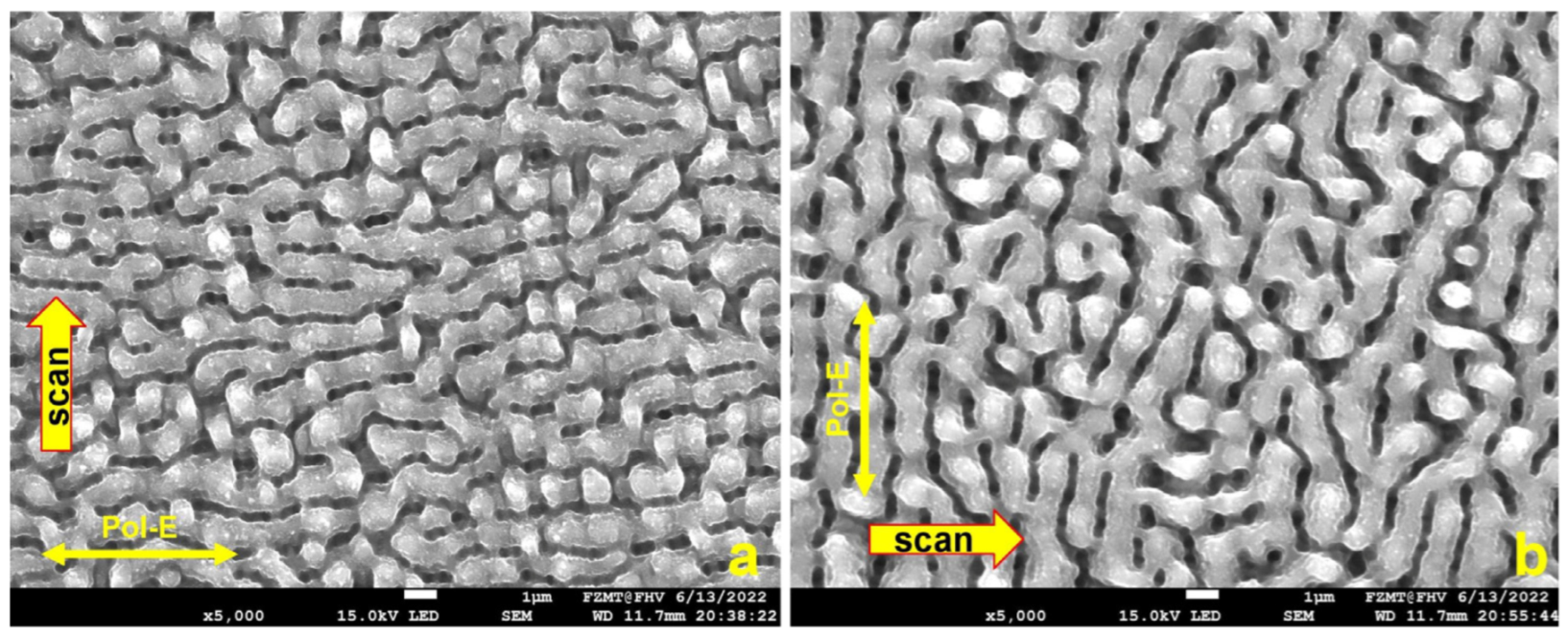
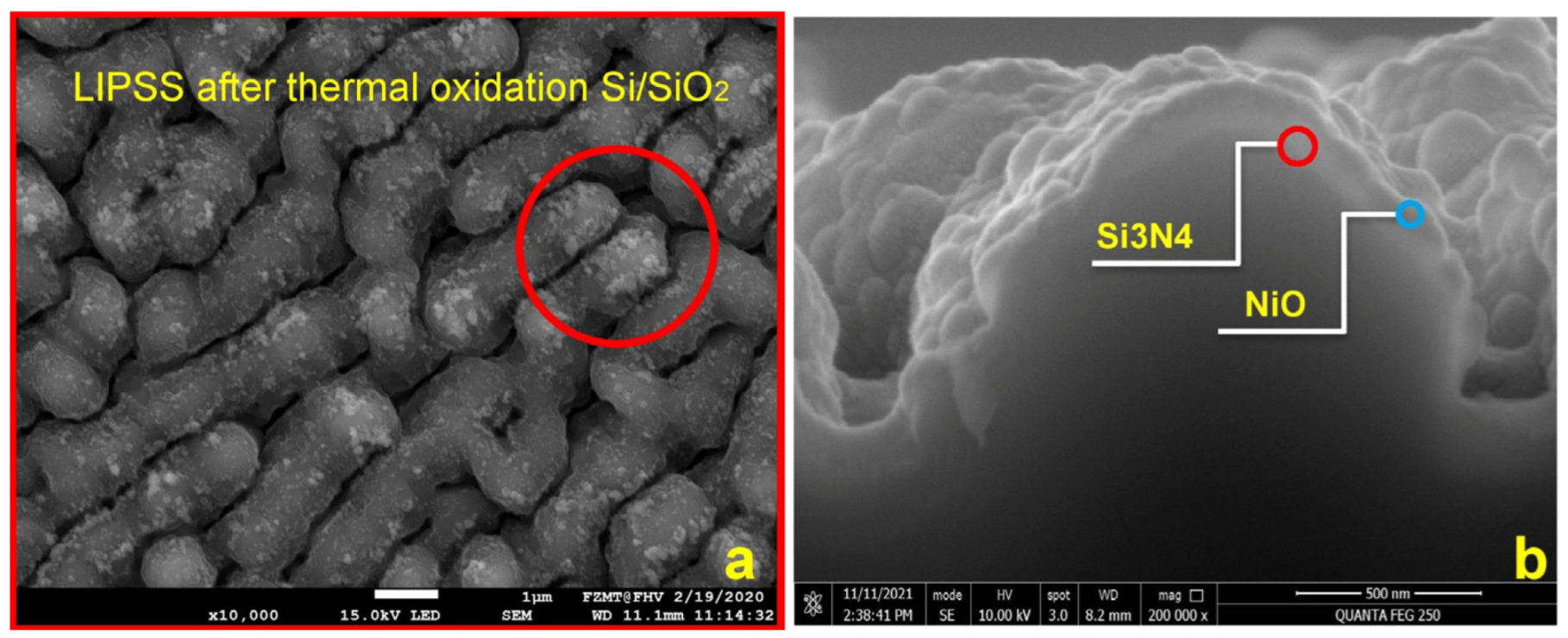
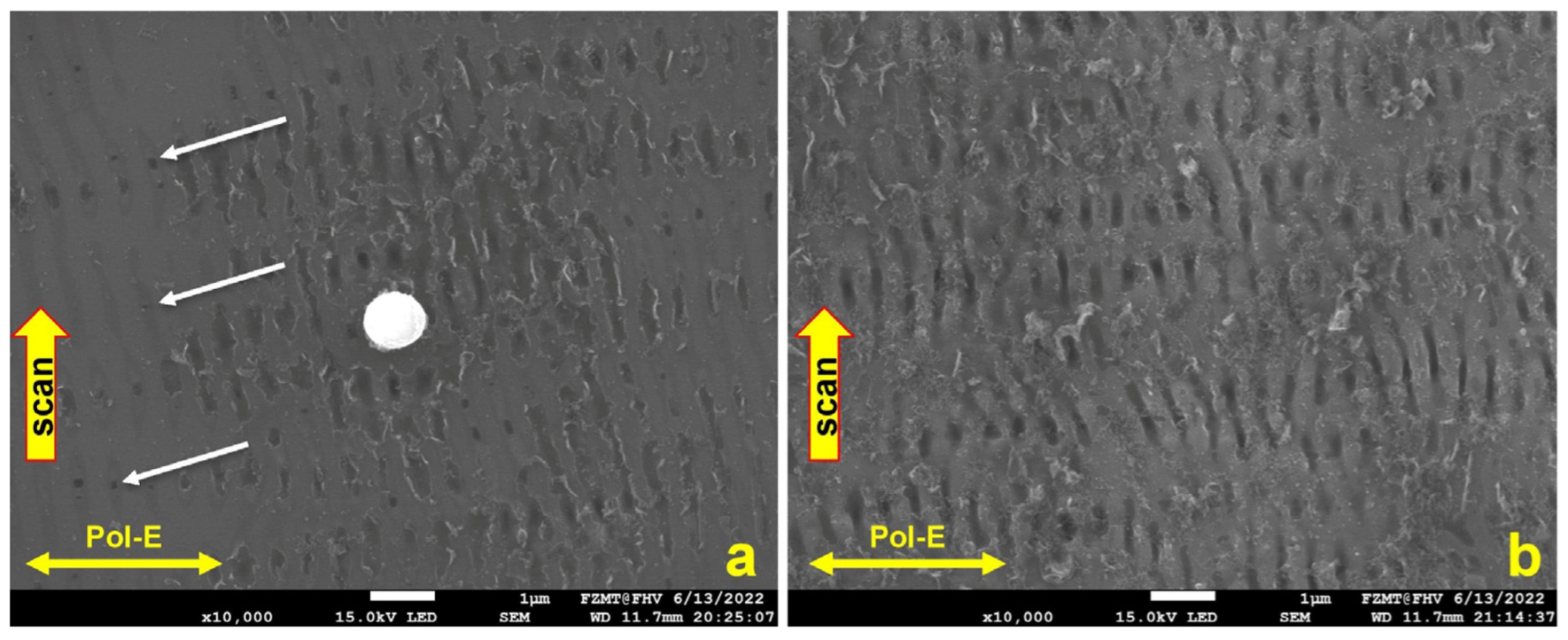
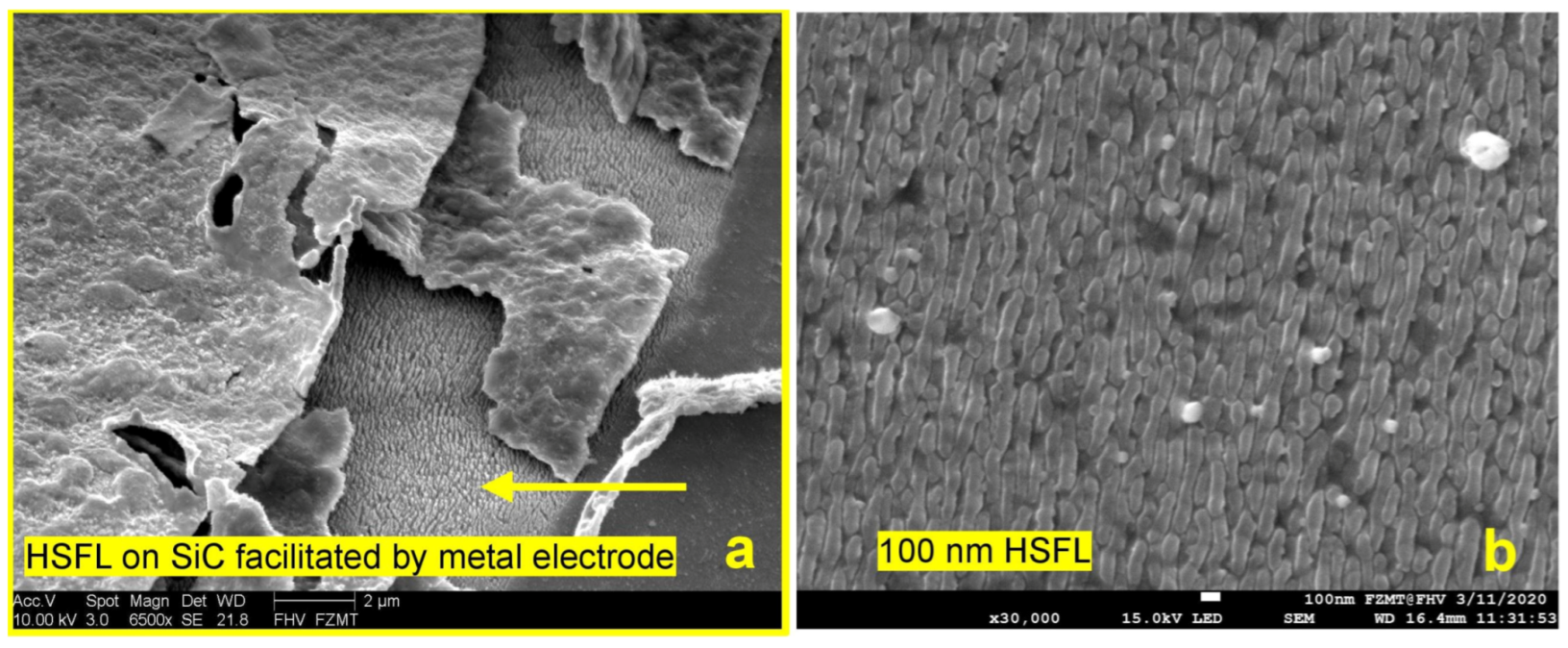
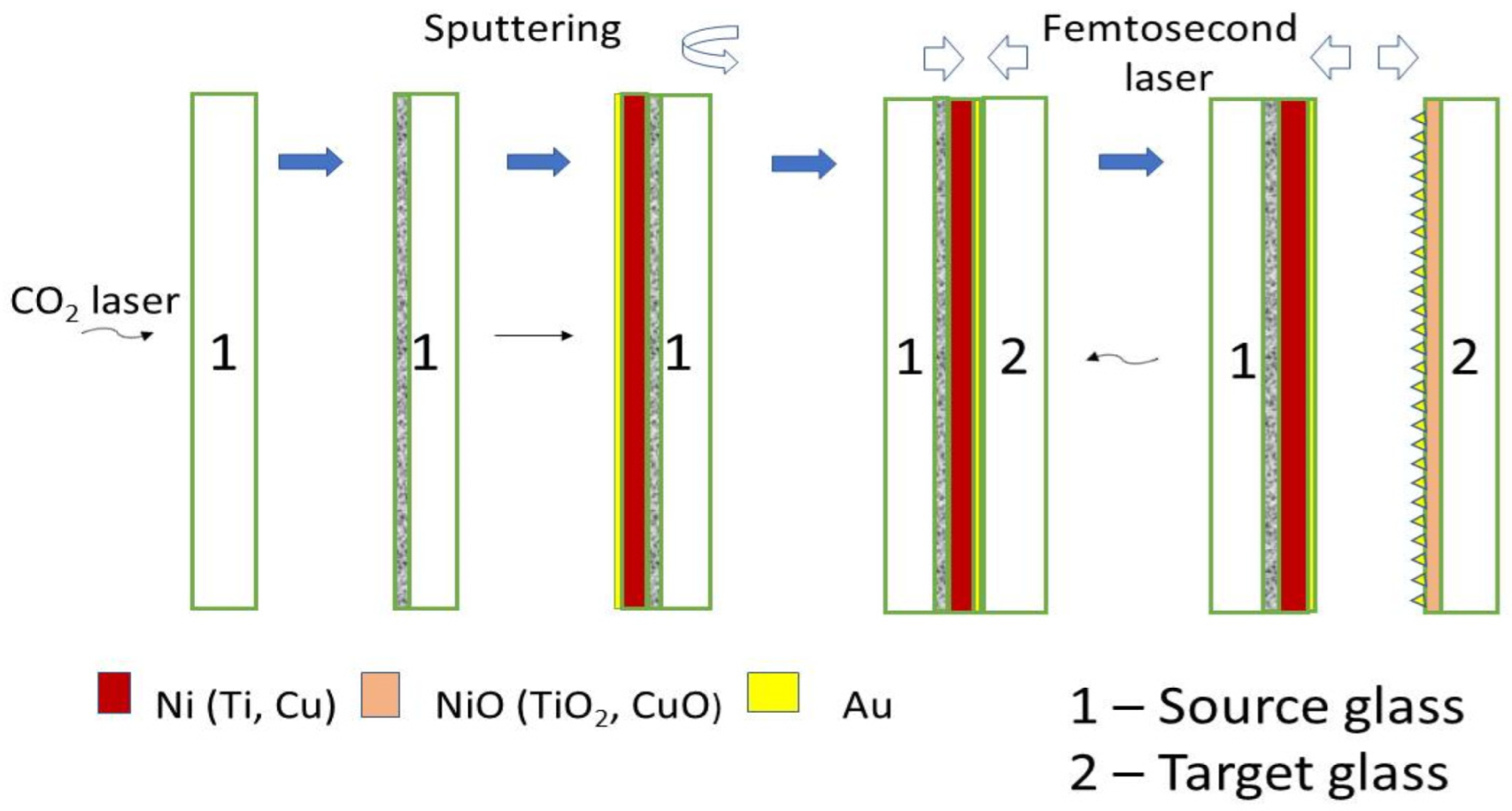

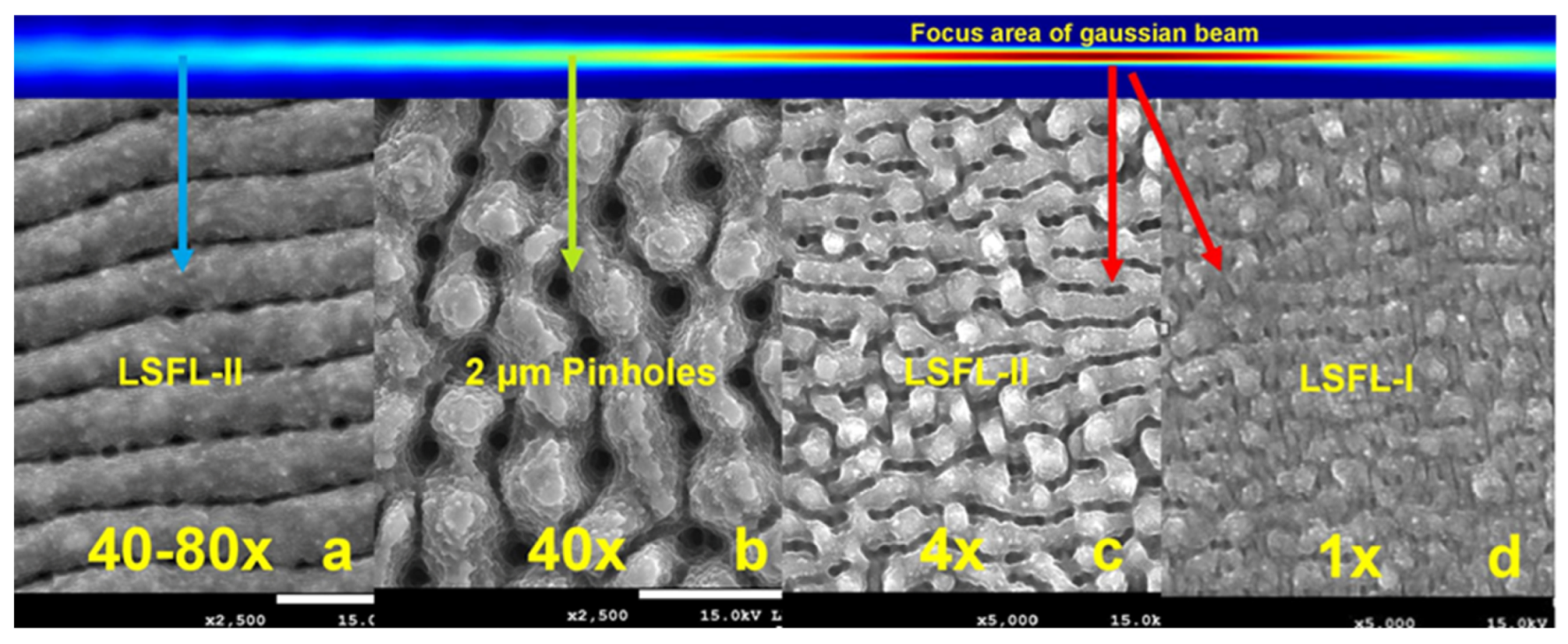
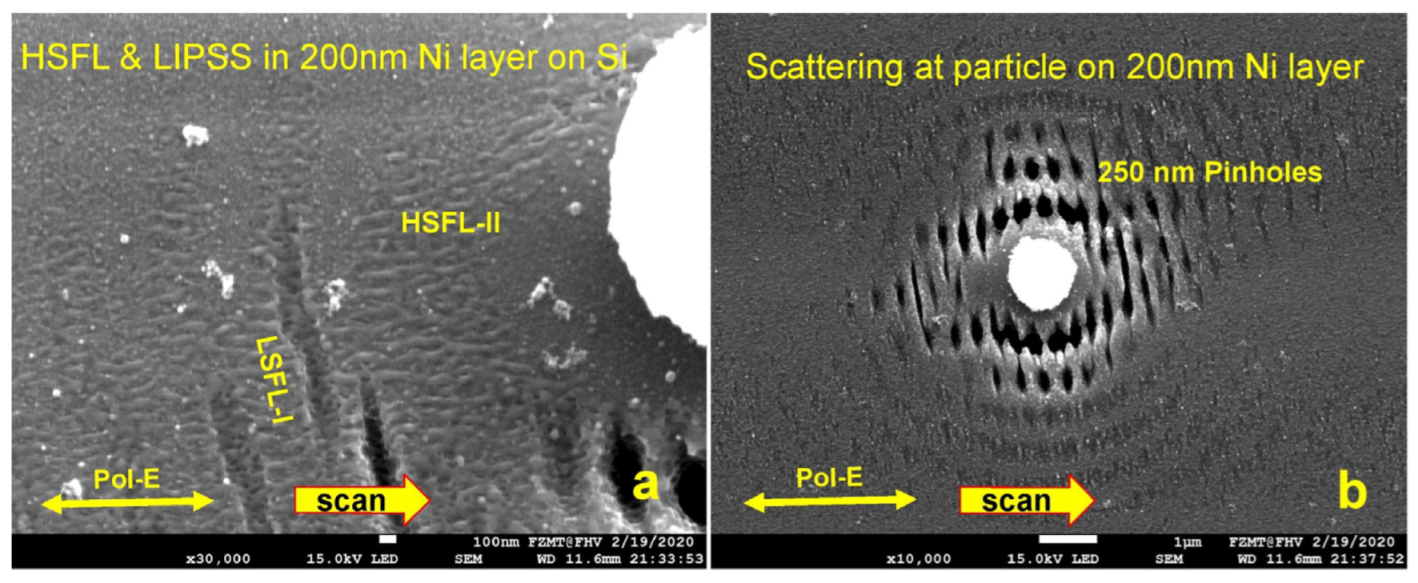
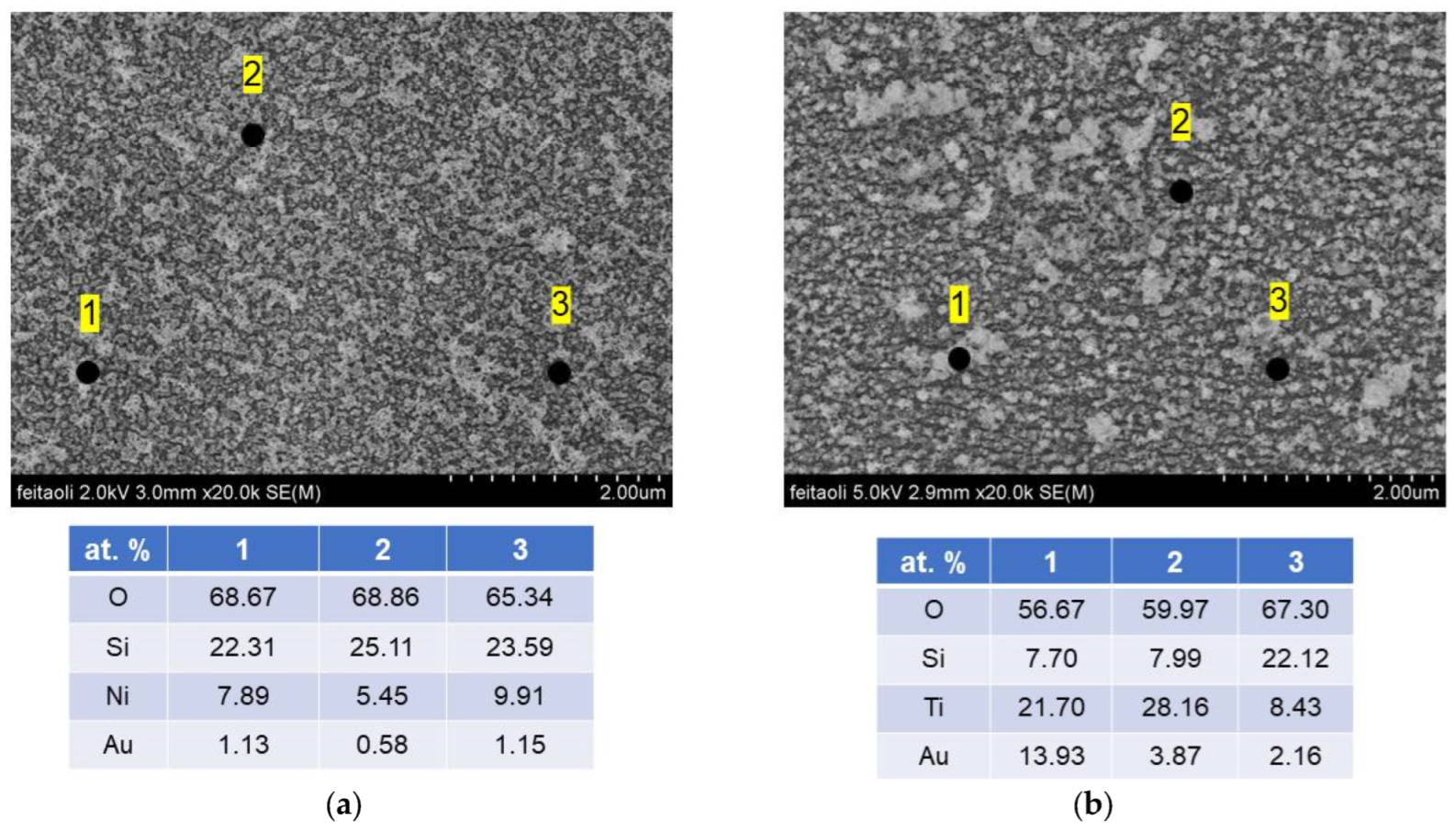
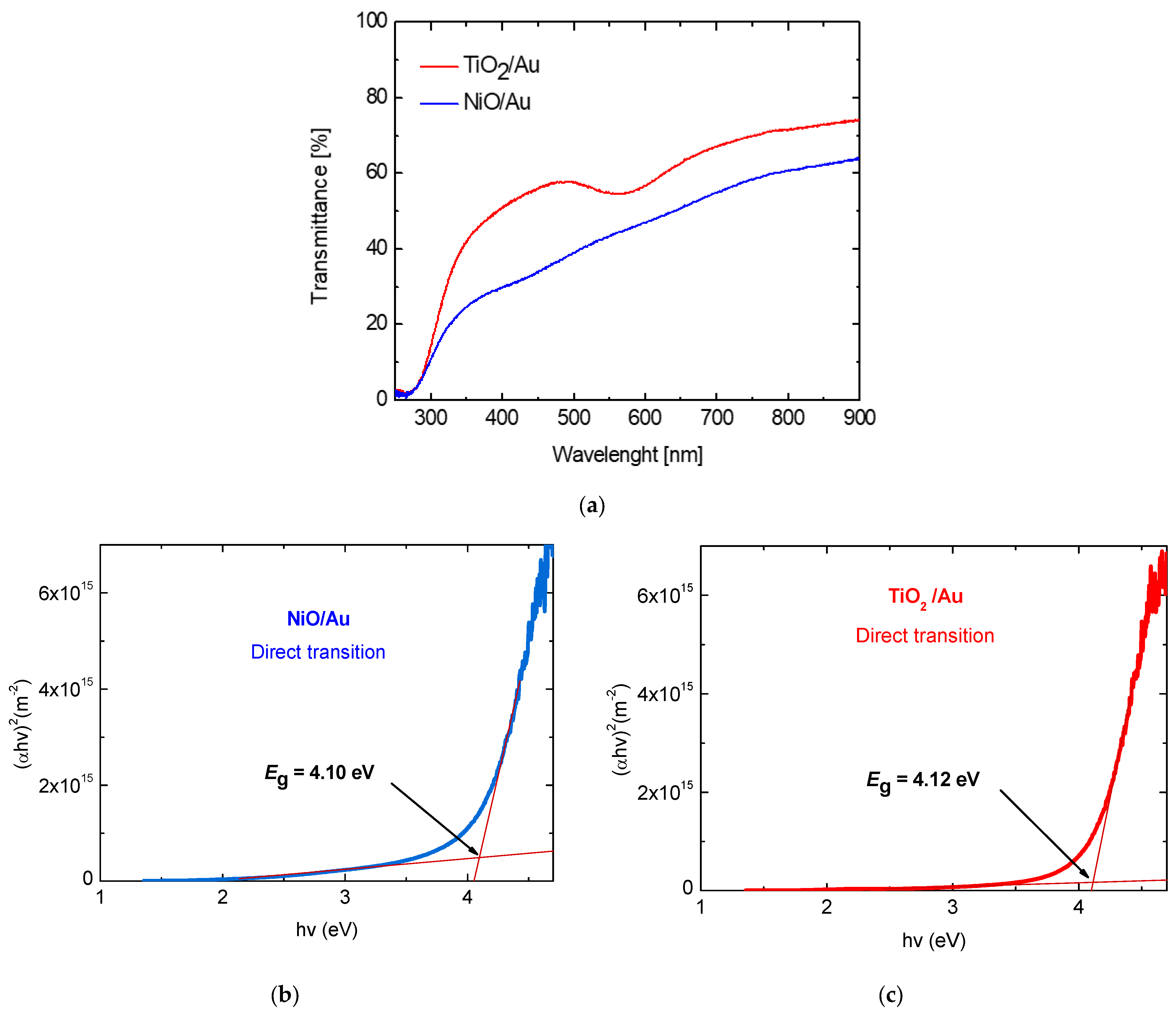
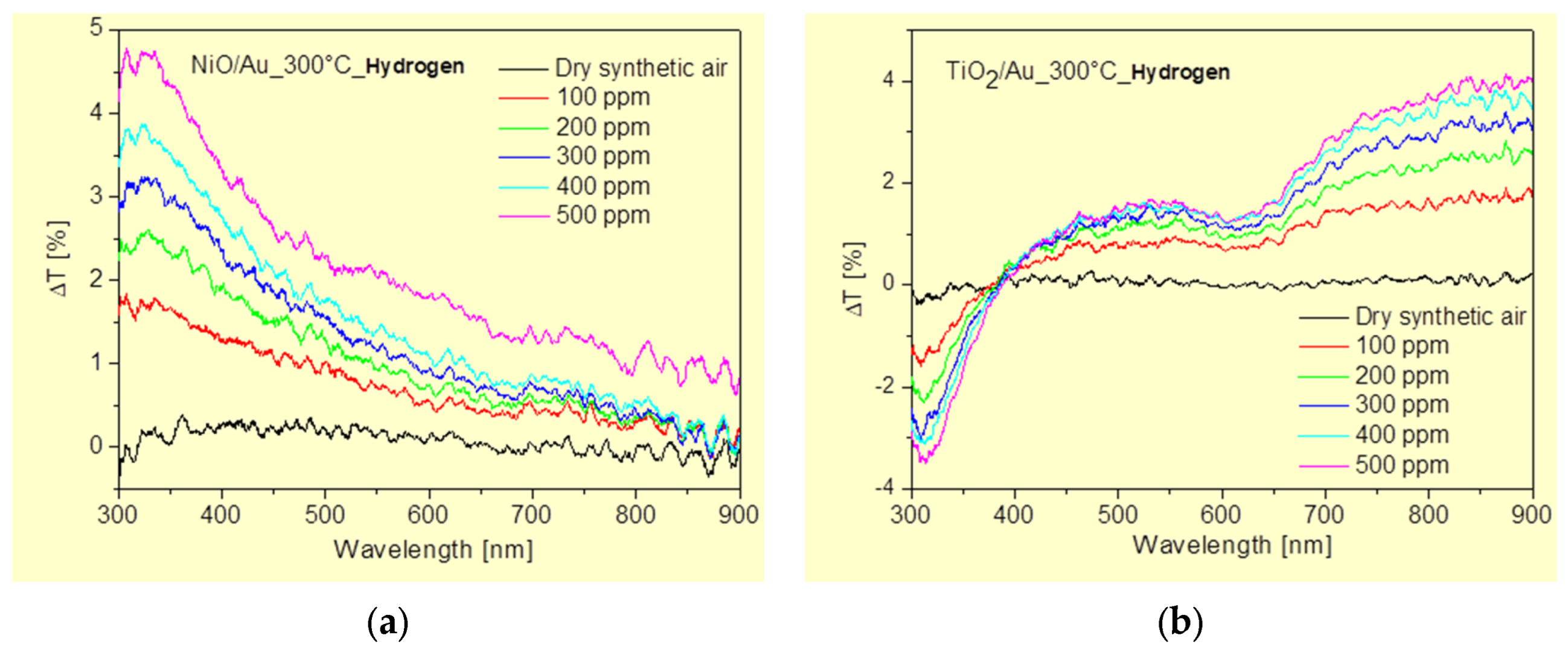
Disclaimer/Publisher’s Note: The statements, opinions and data contained in all publications are solely those of the individual author(s) and contributor(s) and not of MDPI and/or the editor(s). MDPI and/or the editor(s) disclaim responsibility for any injury to people or property resulting from any ideas, methods, instructions or products referred to in the content. |
© 2024 by the authors. Licensee MDPI, Basel, Switzerland. This article is an open access article distributed under the terms and conditions of the Creative Commons Attribution (CC BY) license (https://creativecommons.org/licenses/by/4.0/).
Share and Cite
Zehetner, J.; Hotovy, I.; Rehacek, V.; Kostic, I.; Mikolasek, M.; Seyringer, D.; Dohnal, F. Laser-Induced Periodic Surface Structures and Their Application for Gas Sensing. Micromachines 2024, 15, 1161. https://doi.org/10.3390/mi15091161
Zehetner J, Hotovy I, Rehacek V, Kostic I, Mikolasek M, Seyringer D, Dohnal F. Laser-Induced Periodic Surface Structures and Their Application for Gas Sensing. Micromachines. 2024; 15(9):1161. https://doi.org/10.3390/mi15091161
Chicago/Turabian StyleZehetner, Johann, Ivan Hotovy, Vlastimil Rehacek, Ivan Kostic, Miroslav Mikolasek, Dana Seyringer, and Fadi Dohnal. 2024. "Laser-Induced Periodic Surface Structures and Their Application for Gas Sensing" Micromachines 15, no. 9: 1161. https://doi.org/10.3390/mi15091161
APA StyleZehetner, J., Hotovy, I., Rehacek, V., Kostic, I., Mikolasek, M., Seyringer, D., & Dohnal, F. (2024). Laser-Induced Periodic Surface Structures and Their Application for Gas Sensing. Micromachines, 15(9), 1161. https://doi.org/10.3390/mi15091161







